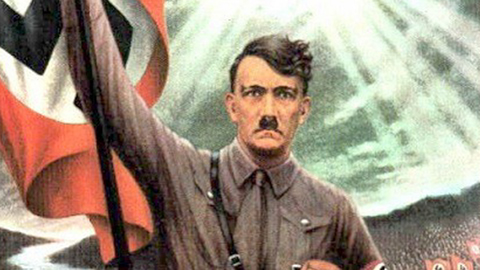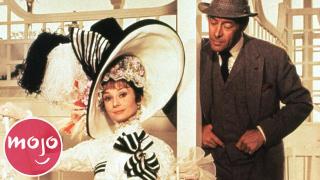Top 10 War Propaganda Films

When war arises, you know it's propaganda time. In this video, http://www.WatchMojo.com counts down our picks for the top 10 war propaganda films. For this list, we're looking at propaganda films from the first half of the 20th century that were effective in promoting their war-related themes. Whether they were made by the "good guys" or the "bad," these propaganda films got the right people riled up, and moved them to action. That means other topics are off limits – so you won't be seeing "Reefer Madness" on this list.
Special thanks to our users jkellis, mxlenny94 and Chris Hernandez for submitting the idea on our Suggestions Page at WatchMojo.comsuggest
Top 10 War Propaganda Films
Top 10 Men in Old Hollywood Films Who Give Major Red Flags Now
When war arises, you know it’s propaganda time. Welcome to WatchMojo.com, and today we’re counting down our picks for the top 10 propaganda films. For this list, we’re looking at propaganda films from the first half of the 20th century that were effective in promoting their war-related themes. That means other topics are off limits.
#10: “Thirty Seconds Over Tokyo” (1944)
Released by Metro-Goldwyn-Mayer, this propaganda film combines footage of actors and real soldiers to tell the story of the first air strike by the U.S. against Japan following the attack on Pearl Harbor, known as the Doolittle Raid. Great effort was made to ensure the film was as realistic as possible, with soldiers who fought in the raid offering perspective and genuine footage of real bombers used. The result is a compelling and human film that paints a picture of what life during wartime was like.
#9: “Moscow Strikes Back” (1942)
This documentary takes viewers right to the heart of the Battle of Moscow, between the Soviets and Hitler’s German forces. Gritty and raw, the propaganda film features brutal shots of war fatalities interwoven between real scenes of battle. But its power relies on its patriotism; the Russians are depicted as a tough, strong and irrepressible people. The winner of the USSR’s Stalin Prize, “Moscow Strikes Back” was also reedited for time and content for U.S. audiences, and that version won an Academy Award.
#8: “Olympia” (1938)
Joseph Goebbels was Nazi Germany’s Minister of Propaganda, but Leni Riefenstahl was the woman behind the camera, who broke new ground in terms of filmmaking techniques. Released only one year before the start of World War II, “Olympia” aims to show the glory, strength and “peacefulness” of Germany by showing the success of the 1936 Berlin Olympic Games. Though the film, and Riefenstahl herself, soon fell into disfavor in the United States and elsewhere, the importance of this propaganda film cannot be denied.
#7: “Casablanca” (1942)
It’s a universal story of love, loss and doing what’s right, all set against the backdrop of World War II. And that’s exactly why “Casablanca” works so well as propaganda: everyone can identify with its characters. Though its patriotic elements are arguably subtle, they are undeniably undeniable as Rick and Ilsa struggle against the fascists. Emotion, fear, and even music help sway the audience; and since “Casablanca” was released squarely in the middle of the Second World War, it was a valuable tool against the Axis Powers.
#6: “The Eternal Jew” (1940)
Top 10 Romantic Films That Make Guys Cry
Another film made at the behest of Joseph Goebbels, this piece of Nazi propaganda was decidedly anti-Semitic and used as a tool to prepare the public for the Holocaust. Already experts at using propaganda to shape public opinion, the Nazis unfairly painted Jews as soulless, uncivilized parasites that must be exterminated. With real as well as staged footage taken of Jews in Polish ghettos shortly after the Nazi occupation, “The Eternal Jew” was not a commercial success – but it was instrumental as a propaganda apparatus.
#5: “Why We Fight” (1942-45)
Top 50 Best Action Films of All Time
Commissioned by the U.S. government and mostly directed by Frank Capra – the man behind films like “Mr. Smith Goes to Washington” – “Why We Fight” is a group of seven documentaries that explain why the Americans joined World War II. Created to convince soldiers and the masses to support the war effort, this series aimed to refute similar films made by Axis nations. And Capra used footage from those same films to help highlight the stark differences between fascist countries and democratic ones, and to get the U.S. on board.
#4: “The Great Dictator” (1940)
Top 10 Worst Movies with Great Casts
Though on the surface a silly satire, this Charlie Chaplin film is propaganda at its finest. Chaplin’s first talkie, and his most commercially successful film, “The Great Dictator” came before the U.S. joined the war, and thus Chaplin’s critical message against Hitler and his Nazis and Mussolini and his fascists was controversial – though also popular – at its release. Featuring one of cinema’s most stirring speeches; “The Great Dictator” was practically a call to action for Allied forces, and of immeasurable value as an instrument of propaganda.
#3: “Battleship Potemkin” (1925)
Black and white in more ways than one, this Soviet propaganda film presents viewers with a clear-cut message against Russia’s Tsarist regime. Directed by Sergei Eisenstein as a dramatization of a real-life mutiny that occurred in 1905, “Battleship Potemkin” was a watershed film, as it tested the effects of editing on audiences – and proved how montage could evoke an unparalleled emotional response in viewers. With one of cinema’s most famous sequences as its centerpiece, this film inspired many to parody it, to censor it and to act.
#2: “The Birth of a Nation” (1915)
Top 20 Most Successful Foreign Films
Originally known as “The Clansman,” this piece of propaganda takes place in America following the Civil War. Directed by D.W. Griffith, it was used to enlist newcomers to the Ku Klux Klan, by depicting the KKK as heroes and African-Americans as dense and hostile. Featuring white men in blackface instead of African-American actors, the film was controversial even in 1915, and was protested by the fledgling NAACP. A century after its production, “The Birth of a Nation” still divides with its thematic content but impresses with its cinematic splendor. Before we unveil our top pick, here are a few honorable mentions: - “Churchill’s Island” (1941) - “Bon Voyage” (1944) - “The True Glory: From D-Day to V-E Day” (1945)
#1: “Triumph of the Will” (1935)
Created by Nazi party propagandist Leni Riefenstahl, this is considered by some to be one of history’s best documentaries; however, it is also a propaganda tool commissioned by Hitler himself to promote Germany as a great world power. Showing the 1934 Nuremberg Rally where 700-thousand followers gathered to support the Nazis, the film uses groundbreaking techniques – like aerial photography and distorted perspective – to promote national pride and Hitler as a god-like figure. Severe, focused and terrifying, “Triumph of the Will” is perhaps the most effective weapon of propaganda ever made. Do you agree with our list? What would you choose as the most effective propaganda films? For more mesmerizing Top 10s published daily, be sure to subscribe to WatchMojo.com.


 0
0
 1
1
 flagged
flagged

 0
0
 0
0
 report
report

 0
0
 0
0
 report
report





